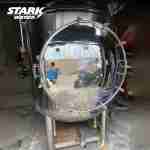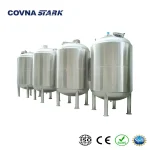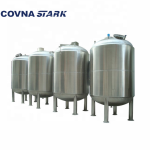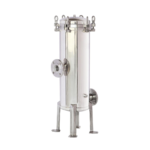Industrial filtration is more than just inserting a filter into your pipeline. It’s a system-level decision that affects your water quality, equipment lifespan, operating costs, and long-term performance. Whether you're treating cooling water, process effluent, or recycled greywater, the right filtration system design can reduce maintenance costs, avoid downtime, and maximize return on investment.
This article provides a practical, step-by-step guide to designing an efficient and cost-effective filtration solution for your industrial process—balancing filtration precision, material compatibility, operating pressure, and total cost of ownership (TCO).
Step 1: Understand Your Water Quality and Flow Requirements
Before selecting any filter type or housing, the first step is to analyze the quality and characteristics of the water or liquid to be treated. Knowing what's in your water—and in what concentration—will determine the filtration precision and system size required.
Key Parameters to Evaluate:
- Suspended Solids (TSS): High solid loads may require pre-filtration or staged filtration.
- Particle Size Distribution: Helps determine the appropriate micron rating for your filter elements.
- pH and Chemical Content: Influences material selection (e.g., stainless steel vs. FRP).
- Flow Rate: Affects filter size, housing diameter, and number of elements needed.
- Temperature: Impacts sealing material, housing expansion, and filter compatibility.
For example, a cooling tower system with high TSS may need a coarse basket filter upstream, while a RO pre-treatment unit requires finer micron-rated cartridge filtration. Skipping this assessment leads to frequent clogging, short service life, and oversized system costs.
Step 2: Define the Level of Filtration Required
Not all contaminants require the same level of filtration. Defining the appropriate micron rating based on your target pollutants is crucial to achieving treatment goals without overdesigning the system.
Common Micron Ratings and Target Contaminants:
- >100 μm: Suitable for large debris, rust flakes, leaves (e.g., cooling tower intake filters).
- 50–100 μm: Sand, grit, visible particles in raw water or process loops.
- 10–50 μm: Suspended solids in recycled water, secondary effluent polishing.
- 1–10 μm: Fine particles in RO pre-treatment, polishing filtration for electronics, beverages, or food industry.
- <1 μm: Ultrafine particulates, colloids, or bacteria; often used in critical process filtration.
Choosing a finer micron rating than needed may result in premature clogging, frequent replacement, and higher pressure drops. Conversely, oversized ratings may allow harmful contaminants to pass through, damaging downstream equipment like pumps, membranes, or chillers.
Step 3: Choose the Filter Type
Once your water quality and micron rating are defined, the next step is to select the right filter type. Each filter style has its own advantages depending on flow rate, contaminant load, maintenance tolerance, and automation level.
Common Filter Types:
- Cartridge Filters: Best for fine filtration (1–50 μm). Ideal for low-to-moderate flow applications. Easy to replace, but require frequent changeouts under high TSS loads.
- Bag Filters: Handle higher dirt-holding capacity (10–200 μm). Suitable for batch processing, wastewater polishing, or backup filters. More economical for medium-solid loads.
- Basket Strainers: Designed for coarse filtration (>100 μm). Ideal as pre-filters to protect pumps or heat exchangers in cooling or circulation systems. Reusable stainless steel elements reduce consumable cost.
- Self-Cleaning Filters: Used in high-flow or critical applications where downtime is unacceptable. Equipped with automatic flushing systems to reduce manual maintenance.
Choosing the wrong type often leads to over-specification, excessive operating costs, or increased labor. For example, using fine cartridge filters in a dirty cooling tower loop without pre-filtration will result in clogging within hours.
Step 4: Select the Right Material
The material of the filter housing and internal components must match the physical and chemical properties of the fluid. Using the wrong material can result in rapid corrosion, contamination, or structural failure—leading to costly downtime or safety risks.
Material Options and Their Applications:
- SUS304 Stainless Steel: Economical and corrosion-resistant for general cooling water, potable water, or neutral process water. Not recommended for aggressive chemicals or high chloride content.
- SUS316 / 316L Stainless Steel: Enhanced resistance to chlorides and acids. Ideal for seawater, brine systems, food and beverage processes, or light chemical effluent.
- FRP (Fiberglass Reinforced Plastic): Lightweight, high corrosion resistance, especially for acidic or alkaline wastewater. Common in plating, textile, and chemical industries.
- Plastic (PVC, PP, PVDF): Suitable for small systems and non-pressurized applications. Often used in lab-scale, soft water, or chemical dosing skids.
Also consider external environment factors like UV exposure, temperature cycles, and installation location (indoor vs. outdoor). For example, FRP housings with UV-resistant coatings perform well in exposed wastewater treatment fields.
Step 5: Consider Maintenance and Long-Term Costs
Filtration systems that are difficult to clean or require frequent part replacement can quickly become operational bottlenecks. That’s why considering ease of maintenance, replacement intervals, and system accessibility is just as important as filter performance.
Key Considerations:
- Filter Replacement Frequency: Cartridge filters may need frequent changeouts depending on TSS; basket filters are reusable but require manual cleaning.
- Downtime Impact: In 24/7 operations, even 1 hour of unplanned downtime can disrupt production schedules or damage equipment.
- Maintenance Access: Ensure that the filter housing is positioned for safe and fast access—especially if it requires tool-free disassembly or overhead clearance.
- Availability of Spares: Standard-sized filters and housings reduce procurement delays and ensure fast replacement.
When designing your system, calculate not just the initial purchase price, but also the Total Cost of Ownership (TCO): replacement frequency, labor time, cleaning effort, and potential process disruption. A cheaper filter that clogs weekly may cost you more than a higher-quality, low-maintenance design in the long run.
Step 6: Optimize for Pressure Loss and Layout Constraints
Even the best filtration media won’t perform well if the system suffers from excessive pressure drop or improper flow velocity. Filtration must work within the overall hydraulic balance of your process.
Key Engineering Parameters:
- Pressure Drop (ΔP): Every filter introduces resistance to flow. Ensure that your pumps can handle the pressure loss across the housing and media—especially during peak contamination loads.
- Flow Velocity: Keep flow rates within recommended limits to prevent channeling or filter damage. For example, pleated cartridge filters typically operate at 1–3 m³/h per element.
- Inlet/Outlet Orientation: Vertical or horizontal configurations may affect sediment settling and ease of drainage. Basket filters should have bottom drain ports; cartridge housings may require air release vents.
- Space Constraints: Account for filter height, lid clearance, and access to fasteners during maintenance. Oversized filters may not fit inside existing skids or equipment rooms.
A well-integrated filter system aligns with your pipeline layout, pump capacity, and on-site maintenance workflow—avoiding costly surprises after installation. Always request dimension drawings and pressure loss curves from the supplier to confirm compatibility.
Conclusion: A System Approach Saves More Than a Single Filter
Choosing the right industrial filtration system isn't just about selecting a filter—it’s about aligning filtration performance with process requirements, fluid characteristics, and operational realities. When done correctly, a well-designed filtration system minimizes maintenance, maximizes equipment protection, and lowers your long-term operating costs.
At STARK, we help industrial clients design customized filtration solutions that strike the perfect balance between cost, durability, and ease of operation. Whether you’re treating cooling water, pre-filtering before RO, or managing wastewater solids, our team can assist with product selection, sizing, and layout integration.
Looking to upgrade or design a new filtration system? Contact us today for expert consultation and technical drawings tailored to your process.





